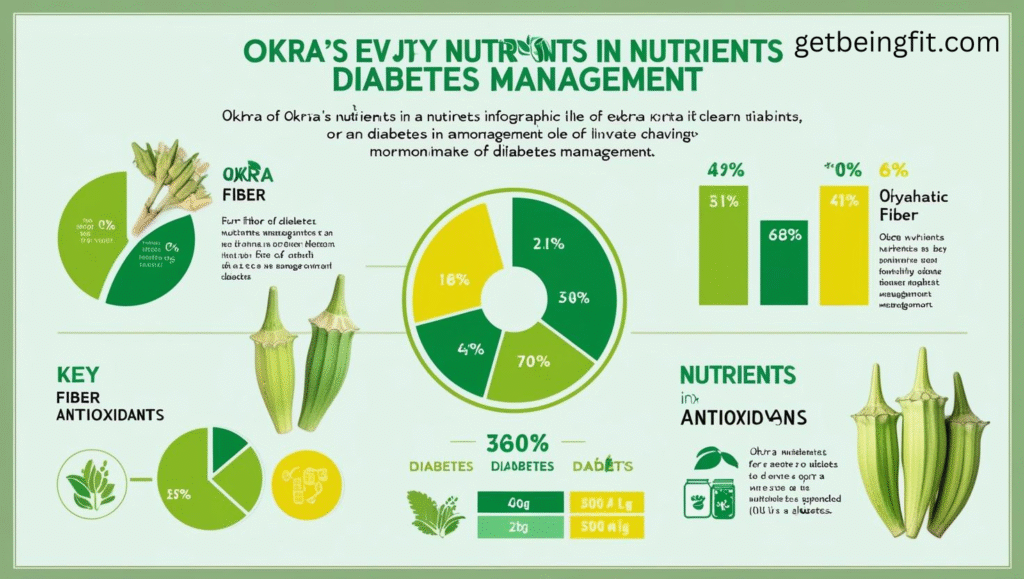Can ladyfinger (okra) help with diabetes? Discover how okra water and its nutrients may support blood sugar management naturally. Plus, try 3 easy, tasty recipes today!
Introduction: The Okra-Diabetes Connection
Ladyfinger (okra) has been used in traditional medicine for years as a natural remedy for diabetes—but is there science to back it up? Emerging research suggests that okra’s unique nutrients and fiber may help regulate blood sugar, but it’s not without some caveats.
In this guide, you’ll learn:
- How okra influences blood sugar (science-backed!)
- The truth about drinking okra water
- 3 simple ways to add okra to your diet
- Who should avoid it and why

1. Does Lady Finger (Okra) Help Lower Blood Sugar?
Science Says: Yes, But Here’s How.
Okra has three standout nutrients that may aid blood sugar management:
- Soluble Fiber (Mucilage): Slows down sugar absorption in your digestive system.
- Polyphenols & Flavonoids: These antioxidants improve how your body uses insulin.
- Myricetin: A special compound that may actively lower blood glucose levels.
Fun Fact: A 2021 study in Phytotherapy Research revealed that okra extract reduced fasting blood sugar by 15% in diabetic rats. While promising, human trials are limited, so consider it as a supportive option,
Okra [Abelmoschus esculentus (L.) Moench] improved…

2. Okra Water for Diabetes: Miracle or Myth?
What is okra water? It’s made by soaking sliced okra pods in water overnight and drinking the strained liquid the next morning.
Does It Work?
- Pros: ✅ May lower fasting glucose (based on anecdotal evidence). ✅ Packed with antioxidants, plus it’s calorie-free. ✅ Great for staying hydrated.
- Cons: ❌ Clinical evidence is still lacking. ❌ Can interact with diabetes medications, increasing the risk of low blood sugar.
How to Make It:
- Slice 2 fresh okra pods.
- Soak them in a glass of water overnight.
- Strain and drink the water in the morning before eating.
3. Best Ways to Eat Okra for Diabetes
Not keen on slimy okra water? Try these quick, diabetes-friendly recipes instead:
- Roasted Okra (Crispy & Low-Carb): Toss fresh okra with olive oil, salt, and turmeric, then bake at 200°C for 20 minutes.
- Okra Stir-Fry (High-Fiber): Sauté sliced okra with garlic, ginger, and colorful bell peppers for a vibrant side dish.
- Okra Green Smoothie: Blend okra with spinach, cucumber, and a splash of lemon juice for a refreshing, fiber-packed drink.
4. Who Should Be Cautious?
While okra offers potential benefits, it’s not for everyone: ⚠ Avoid if you:
- Take blood sugar-lowering medications (risk of hypoglycemia).
- Suffer from kidney stones (okra contains oxalates).
- Can’t handle its slimy texture—try roasting instead!
Conclusion: Should You Add Okra to Your Diet?
Okra is a natural, nutrient-rich option that may support better blood sugar control. However, it’s not a standalone solution—pair it with a balanced diet, regular exercise, and guidance from your doctor for best results.

Next Step: Try drinking okra water for a week and track how it affects your glucose levels.
(Image Idea: Someone checking their blood sugar after drinking okra water.). Alt Text: “Diabetic monitoring blood sugar with okra water.”
FAQs
Q1: How much okra should I eat daily as a diabetic?
A1: 1–2 medium pods. Eating too much could lead to bloating or discomfort.
Q2: Can I replace my medication with okra?
A2: Absolutely not—always consult your doctor first.
Q3: Does cooking okra remove its benefits?
A3: Light cooking preserves its nutrients. Avoid frying, which adds unhealthy fats.
Q4: Which is better—okra water or eating okra?
A4: Eating whole okra provides more fiber and overall benefits.
Q5: Can okra raise blood sugar?
A5: Very rare, but adding sugar to okra dishes can.


